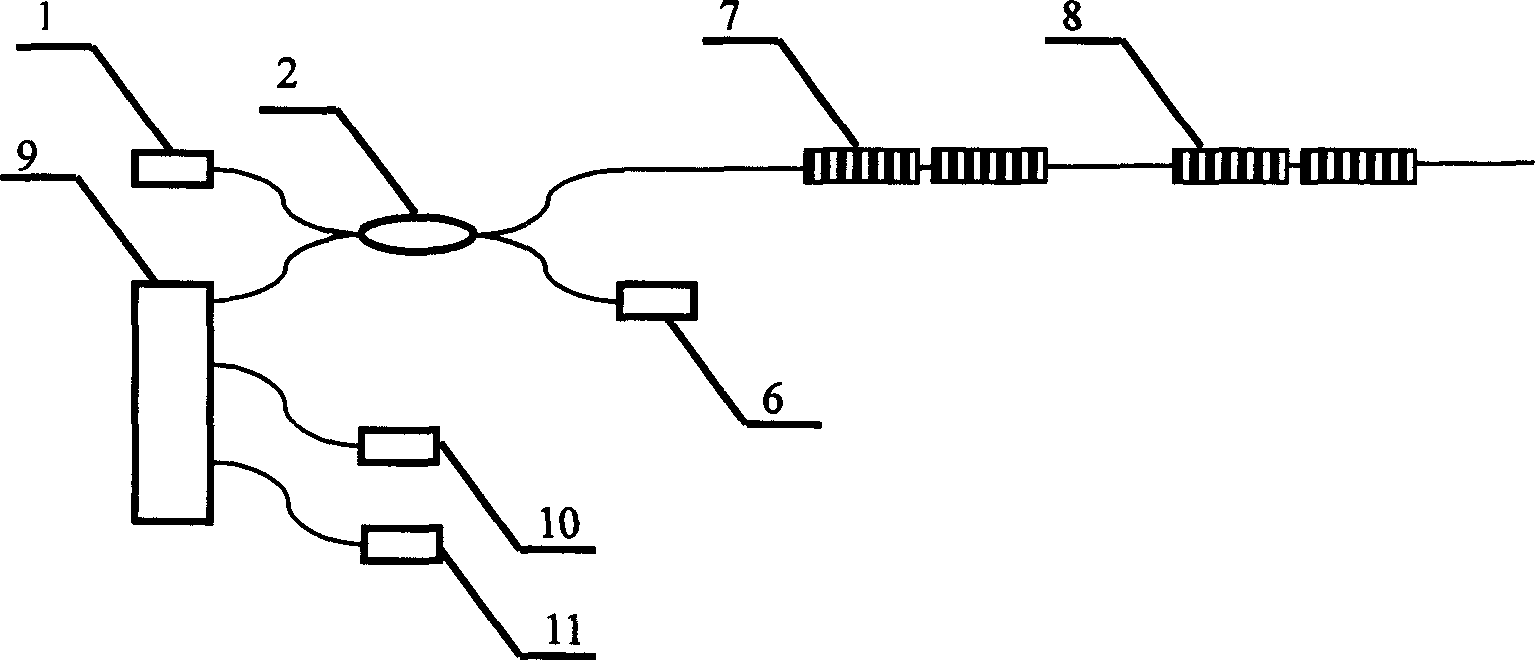Optical fibre grating wavelength demodulating method
A fiber bragg grating and wavelength demodulation technology, which is applied in optical demodulation, optics, instruments, etc., can solve the problems of difficulty in design, manufacture and use, steep edges of demodulation filters, and low response frequency, and achieve good cost performance and convenience Promote the application, the effect of fast response
- Summary
- Abstract
- Description
- Claims
- Application Information
AI Technical Summary
Problems solved by technology
Method used
Image
Examples
Embodiment 1
[0027] The present invention is applied to the case of a single measuring point, as attached figure 1 As shown, the light emitted by the broadband light source 1 enters the 2×2 coupler 2, and then enters the photodetector 6, the fiber Bragg grating 3 and the fiber Bragg grating 4 after being split by 2, wherein the fiber Bragg grating 3 is the reference grating, and the fiber Bragg grating 4 is the measurement raster. The center reflection wavelength difference between the fiber grating 3 and the fiber grating 4 is about 1 / 4 of the reflection bandwidth of a single fiber grating. Under the action of the measured fiber grating 4, the reflection center wavelength will move, that is, the difference between the reflection center wavelength of the reference fiber grating 3 and the measurement grating 4 will change, so that the optical power value measured by the photodetector 5 will change. , and then referring to the measured value of the photodetector 6, and removing the influenc...
Embodiment 2
[0029] This example illustrates how to use the present invention to realize distributed fiber grating sensing. as attached figure 2 As shown, the light emitted by the broadband light source 1 enters the 2×2 coupler 2, and after being split by 2, enters the photodetector 6, the fiber Bragg grating pair 7 and the fiber Bragg grating pair 8 respectively, and the fiber Bragg grating pair 7 and the fiber Bragg grating pair 8 are opposite to each other. The center reflection wavelength difference is 1 / 4 of the reflection bandwidth of a single FBG, and the return light frequency ranges of the FBG pair 7 and the FBG pair 8 should be different, so as to ensure that they can be separated by the wavelength division multiplexer 9 . The return light of the fiber grating pair 7 and the fiber grating pair 8 passes through the 2×2 coupler 2 and enters the wavelength division multiplexer 9. The light is separated and enters the photodetector 10 and the photodetector 11 respectively, and the ...
PUM
 Login to View More
Login to View More Abstract
Description
Claims
Application Information
 Login to View More
Login to View More - R&D
- Intellectual Property
- Life Sciences
- Materials
- Tech Scout
- Unparalleled Data Quality
- Higher Quality Content
- 60% Fewer Hallucinations
Browse by: Latest US Patents, China's latest patents, Technical Efficacy Thesaurus, Application Domain, Technology Topic, Popular Technical Reports.
© 2025 PatSnap. All rights reserved.Legal|Privacy policy|Modern Slavery Act Transparency Statement|Sitemap|About US| Contact US: help@patsnap.com



